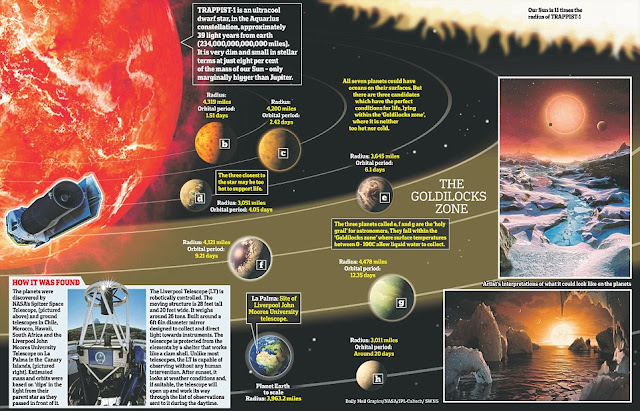Nasa Scientists Discover Double-Star Planet Systems
For quite a long time it has been a standout amongst the most vexing puzzles for humankind: would we say we are, the seven billion occupants of this wondrous blue planet truly alone, or is there life in the distance in the universe? Recently, we came a stage nearer to noting that enticing inquiry with the point of interest declaration by Nasa researchers of the revelation of another nearby planetary group that has no less than three Earth-like planets — with atmospheres that could possibly bolster life.
The interesting new planets are relatively close neighbors, as well, at only 39 light years from Earth. Without a doubt, 39 light years (234 trillion miles) is not really a short bounce.
Be that as it may, that relative nearness will empower cosmologists with ultra-complex telescopes and scanners to concentrate on the planets and affirm if there is water and the generous air required for life to flourish. Thomas Zurbuchen, relate manager of Nasa's Science Mission Directorate in Washington DC, said yesterday: 'These inquiries concerning "are only we" are being replied at this very moment, in this decade and the following decades. This story gives us a clue that finding a moment Earth is not simply an issue of if, but rather when.
Researchers have since quite a while ago theorized that life-supporting planets must exist some place in the universe, however none has ever yet been affirmed as conceivably life-maintaining.Presently space experts say they have recognized no under seven Earth-sized universes circling a red small star — the likeness our sun — called TRAPPIST-1. For more Details Visit New Solar System Discovered by NASA
The seven planets are accepted to be no less than a billion years of age and, in principle, all could have lakes and seas. Yet, three are excessively near the star and, in this manner, prone to be excessively hot, making it impossible to have water, while the furthermost planet is excessively icy. It is the three planets in the center (named TRAPPIST-1 'e', "f" and 'g') that are producing the most enthusiasm as they lie in what is known as the tenable 'Goldilocks Zone' — neither excessively hot nor excessively frosty forever, making it impossible to flourish. The surface temperatures extend from zero to 100c, so water won't bubble off as vapor. Likewise, planet "e" is shut in size to Earth and gets about a similar level of light from its star.
NASA Finds More SOLAR SYSTEM and 3 Planets
The revelation by a global group utilizing propelled telescopes in space and at far-flung areas around the globe has brought about a free for all of energy among cosmologists who, as a breed, are not given to overstatement.The interesting new planets are relatively close neighbors, as well, at only 39 light years from Earth. Without a doubt, 39 light years (234 trillion miles) is not really a short bounce.
Be that as it may, that relative nearness will empower cosmologists with ultra-complex telescopes and scanners to concentrate on the planets and affirm if there is water and the generous air required for life to flourish. Thomas Zurbuchen, relate manager of Nasa's Science Mission Directorate in Washington DC, said yesterday: 'These inquiries concerning "are only we" are being replied at this very moment, in this decade and the following decades. This story gives us a clue that finding a moment Earth is not simply an issue of if, but rather when.
Researchers have since quite a while ago theorized that life-supporting planets must exist some place in the universe, however none has ever yet been affirmed as conceivably life-maintaining.Presently space experts say they have recognized no under seven Earth-sized universes circling a red small star — the likeness our sun — called TRAPPIST-1. For more Details Visit New Solar System Discovered by NASA
The seven planets are accepted to be no less than a billion years of age and, in principle, all could have lakes and seas. Yet, three are excessively near the star and, in this manner, prone to be excessively hot, making it impossible to have water, while the furthermost planet is excessively icy. It is the three planets in the center (named TRAPPIST-1 'e', "f" and 'g') that are producing the most enthusiasm as they lie in what is known as the tenable 'Goldilocks Zone' — neither excessively hot nor excessively frosty forever, making it impossible to flourish. The surface temperatures extend from zero to 100c, so water won't bubble off as vapor. Likewise, planet "e" is shut in size to Earth and gets about a similar level of light from its star.




Comments
Post a Comment